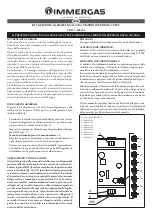
80
11.12
TEMPERATURE RISE AT FULL FIRING RATE
1. The pump must run continuously when the burner is firing.
2. With the pump running and the burner in the appliance in the off cycle, the inlet temperature and outlet temperature readings on
the display should read approximately the same temperatures.
3. Turn the hot water heater on and allow time for the temperature to stabilize. Check the temperature rise when the burner is firing
at 100% of rated input.
4. Compare the temperature rise on the
Advantus
display with the expected temperature rise.
If the temperature rise is too high, adjust as follows:
1. Check for flow restrictions. Check for debris in strainers
2. Check diameter and equivalent length of the piping between the storage tank and hot water heater.
3. Be sure all valves are open between the hot water heater and the storage tank. Ensure that all ball valves are fully ported.
4. Check the pump to be sure it is running properly and that the pump motor is running in the proper direction.
5. Be sure the pipes between the hot water heater and storage tank are not more than a total of 80 equivalent feet between inlet
and outlet lines. If maximum equivalent length for the specified pipe diameter is exceeded, larger diameter pipe may have to be
installed to achieve correct flow and temperature rise.
6. Common manifold piping for multiple unit installations will require larger minimum pipe sizes and tank circulating tapping to
ensure proper flow.
7. Check PID settings and on/off hysteresis.
If the temperature rise is too low, adjust as follows:
1. Temperature rise can be increased by slowly closing the flow control valve (globe valve or flow setter) in the outlet piping from
the hot water heater to the storage tank to achieve the proper temperature rise.
The required temperature rise and the recommended pump size are based on the heating of potable water with normal hardness. Consult
the factory when heating potable water exceeding these specifications. For DHW applications with other than normal hardness, choose
a pump for the local water hardness conditions. Alternatively, soften the water to normal levels. Damage to the heat exchanger as a result
of scaling or corrosive water conditions in non-warrantable.
CAUTION
Temperature rise cannot be adjusted when the burner is firing at less than 100% of input rate.
11.13
WATER HEATERS
The manufacturer recommends the use of a properly sized thermostatic mixing valve to supply domestic hot water at temperatures less
than 140°F (60°C). Storing the water at a higher temperature and thermostatically mixing the water will decrease the size of the storage
tank and increase the available quantity of mixed hot water.
Piping components connected to the water heater for a space heating application shall be suitable for use with potable water.
Toxic chemicals, used for boiler treatment, shall not be introduced into the potable water used for space heating
A water heater which will be used to supply potable water shall not be connected to any heating system or component(s)
previously used with a non-potable water heating appliance
When a system requires water for space heating at temperatures higher than required for other uses, a means such as a mixing
valve shall be installed to temper the water for those uses in order to reduce scald hazard potential.
CAUTION
Adequate care
MUST
be taken to prevent potential scald injury when storing water at 140°F (60°C) and hotter.
WARNING
Should overheating occur or the gas supply fail to shut off, do not turn off or disconnect the electrical supply to the pump, instead,
shut off the gas supply at a location external to the appliance.
Summary of Contents for ADVANTUS AVH 500
Page 2: ......
Page 3: ......
Page 38: ...31 Figure 23 Recommended Piping with Reverse Return and Variable Primary Flow...
Page 88: ...81 PART 12 EXPLODED VIEW Figure A...
Page 89: ...82 Figure B FAN BURNER ASSEMBLY AV500 600 some items may not be as shown...
Page 90: ...83 Figure C FAN BURNER ASSEMBLY AV800 4000 some items may not be as shown...
Page 91: ...84 Figure D Figure E...
Page 92: ...85 Figure F Figure G...
Page 93: ...86 Figure H CONTROL BOARD ASSEMBLY...
Page 100: ...93 PART 13 ELECTRICAL DIAGRAMS...
Page 101: ...94...
Page 102: ...95...
















































